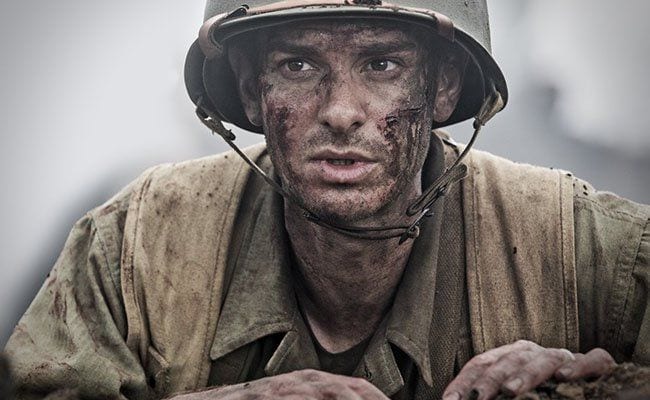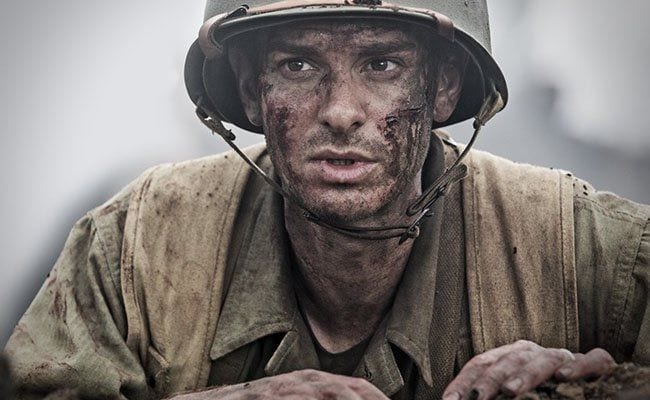
Mel Gibson’s new war biopic, Hacksaw Ridge, is an orgiastic celebration of violence and viscera that will leave you in serious need of a shower. His obsession with glamorized gore undermines this amazing real-life story of genuine American heroism. What should be an inspiring statement about moral conviction in the face of unspeakable horror is, instead, an unrewarding endurance test that settles for splendidly-staged war porn. Yes, Mel is back, and he’s bloodier than ever.
The bravery of United States Army medic Desmond Doss cannot be quantified, but 75 might be the number that comes closest. That’s the number of fallen soldiers he single-handedly pulled to safety under a hail of enemy gunfire — all while refusing to carry a weapon! Doss was the first Conscientious Objector awarded the Medal of Honor for the instrumental role he played during the Battle of Okinawa in World War II.
So why does a movie based upon the exploits of a real-life hero feel so empty and ugly? Simply put, Doss’s inspiring story is merely the backdrop for a shallow action movie that uses family-friendly themes to broaden its box office appeal.
As the story opens, Desmond Doss (Garfield) is a Gump-like country bumpkin who believes in God, country, and his mama (Rachel Griffiths). In that order.
“You’ve got to sit and think and pray about everything,” laments his alcoholic father (Hugo Weaving), who uses a bottle to drown the haunting screams of his fallen war buddies. During a decidedly awkward family dinner, father delivers a devastating speech about witnessing the gruesome death of his best friend on a battlefield in France. Thanks to Weaving’s impeccable delivery, this verbal description of war’s atrocity easily eclipses any of Gibson’s graphic depictions.
A listless first act follows young Doss on his journey from carefree boy to slightly-less carefree boy. He races around the Virginia countryside with his brother, trying to suppress the guilt he feels over not yet enlisting. He also finds time to romance a beautiful young nurse, Dorothy (Teresa Palmer), by donating blood at a nearby hospital. Gibson lingers over the needle puncturing Doss’s arm, just in case you forgot how blood draws work.
One of the major flaws in Hacksaw Ridge is Andrew Garfield’s inability to command the screen. Though he shows some perceptive comic timing, including a cute little scene when Dorothy slaps him after an impromptu kiss, Garfield simply lacks the presence of a dramatic leading man. Desmond Doss may be a meek, understated figure, but he has the heart of lion. Garfield captures the lamb, but fails to convince as a lion.
Things pick up slightly after Doss finally enlists as a Conscientious Objector. His baffled Platoon Leader (Vince Vaughn) and livid Commanding Officer (Sam Worthington) try everything to court martial the young pacifist for refusing to carry a rifle. Doss also gets the Full Metal Jacket treatment from his platoon mates, who beat him savagely for his perceived weakness. Vaughn brings some much needed ‘drill instructor humor’ to this dreary affair, wryly observing that he’s seen “stalks of corn with better physiques” than the scrawny Doss.
But enough with this boring exploration of Doss’s struggle to remain true to his beliefs; it’s time to unleash the carnage!
While some (including Gibson himself) fancy Hacksaw Ridge as an “anti-war movie”, it never misses an opportunity to glorify the butchery. This is not a realistic depiction of the horrors of war; this is a balletic love letter filled with slow motion slashing and gorgeous plumes of gasoline Hell fire. It’s difficult to tell which has a greater hunger for the grizzly detritus; the scurrying trench rats or Mel Gibson.

The camera luxuriates over every sucking chest wound and mutilated limb. Indeed, Gibson is a master of snuff cinema, displaying a flair for the ghastly in everything from Braveheart to Apocalypto. None of this would be offensive, of course, were it not in direct conflict with the over-arching themes of Hacksaw Ridge. The real-life story of Desmond Doss isn’t one of depravity and ugliness, but of the beauty and conviction of the human spirit. By glamorizing all that Doss despises, Gibson diminishes his hero to second fiddle in an orchestra of violence. Indeed, Hacksaw Ridge might have benefitted from a PG-13 treatment of Doss’s heroics.
The high point of Gibson’s film, and what should have served as the film’s emotional centerpiece, are the sequences involving Doss’s bravery on Hacksaw Ridge. With his platoon repelled by a revitalized Japanese force, Doss spends a harrowing evening trapped alone on the Ridge. Roving Japanese forces inspect the dead as Doss scrambles to aid the living. As if he needed another obstacle, Doss must also build a system to lower his patients down the steep precipice that separates Hacksaw Ridge from the American troops stationed below.
These scenes crackle with an intoxicating energy. We’re no longer watching faceless soldiers being blown to bits in a pointless action spectacle; we’re watching one man sacrifice his own safety in order to save countless lives.
“Please, Lord, help me get one more,” Doss pleads before pulling each wounded soldier from the rubble. It’s a mantra that both energizes and protects Doss from almost certain death. At one point, he finds himself rendering aid to a wounded Japanese soldier inside a disorienting labyrinth of water-logged tunnels. It’s in these fleeting moments, when Gibson sweeps aside the fog of war and finds a ray of light at its center, that Hacksaw Ridge fulfills the promise of its stalwart hero.
Fans of hardcore battlefield action will find plenty to enjoy in Hacksaw Ridge, but those seeking emotional enlightenment will be disgusted (and bored) by Gibson’s return to the director’s chair. Were he alive today, it’s unlikely that Desmond Doss would understand such a gratuitous depiction of his moral calling. Gibson’s allegiance to bloodshed will probably put asses in the seats, but it’s unlikely to win any hearts and minds.


